
Tang Jian, doctor of engineering, professor, first-class registered architect. Dean of the School of Architecture and Art of Dalian University of Technology, visiting scholar of the School of Architectural Planning of Massachusetts Institute of Technology. He has been engaged in the cultural research of traditional settlements and heritage buildings in Northeast China for a long time, as well as the research on the protection and renovation of existing buildings. Undertake and participate in five national-level projects such as the research topic of major projects of central universities, the research on architectural heritage and its cultural driving role under the comprehensive revitalization of Northeast China, and one project of Liaoning liberal arts development think tank; He has published five books, such as History and Theory of Architectural Environmental Design.
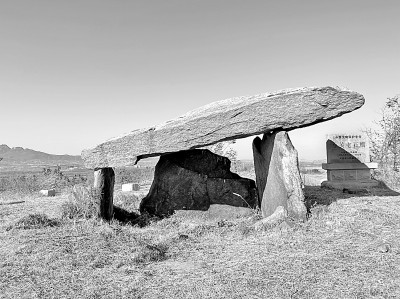
Xiaoguantun shipeng
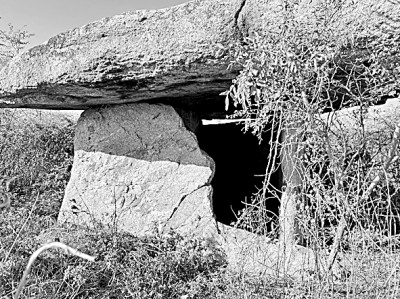
Baidianzi shipeng
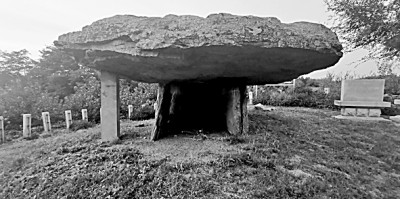
Shipenggou shipeng
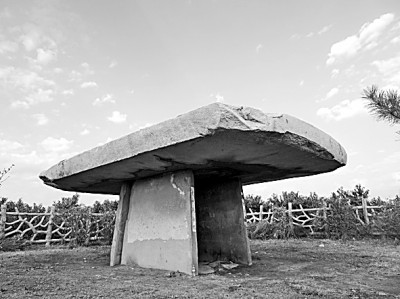
Shipengshan shipeng
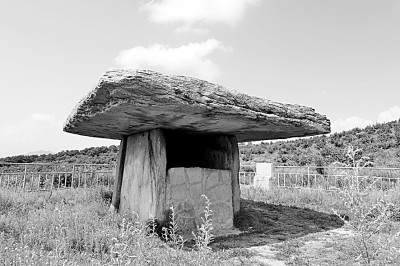
Shimucheng shipeng
The pictures in this edition are all information pictures.
Stone shed is the product of the early megalithic culture in human society. This form of megalithic architecture is widely distributed all over the world, such as Europe, Africa and Asia. Although there are different shapes of stone sheds in different places, the most basic shape is to use multiple stones or slabs as support and build a cover stone at the top. There are different names for the stone shed, which is called Dolmen in English and transliterated as "Dolmen". Some foreign scholars think that the stone shed is similar to the stone-accumulating tomb and the stone-covered tomb and belongs to the category of stone-supporting tomb, so it is called stone-supporting tomb or directly called stone-covered tomb, while in Europe it is often called "stone table" or "stone platform" because of its modeling characteristics. China is usually called a stone shed, but different places have their own names, such as "Gusao Stone" and "Shimiaozi".
Stone shed buildings in China are mostly distributed in Northeast China and Zhejiang, and there are also a few remains in other areas, such as Shandong, Sichuan, Hunan and other provinces. Stone sheds in Northeast China are mainly concentrated in southern Liaoning, and it is recognized by academic circles that they were built from the late Neolithic period to the Shang and Zhou Dynasties, and belong to the same system as the stone tombs in the Korean Peninsula and Japan. The stone shed in southern Liaoning has a complete preservation system and can be regarded as the representative of stone shed architecture in China.
Stone shed buildings in southern Liaoning have long been recorded in ancient Chinese literature. The "Guanshi Xiangrui" discovered in Xiangping (now Liaoyang) during the reign of Emperor Xuandi of the Han Dynasty in the Biography of the Three Kingdoms mentioned: "There are three small stones in the Yanli Society in Xiangping, which are long and long. Or "degree": ‘ This Han Xuandi crowned the auspicious stone. ’” From the description, it can be seen that the "crown stone" in this paper is a stone shed, which is supported by three small stones. Later, a more detailed record about the stone shed architecture in southern Liaoning is the Records of the Walking Department of the Yajiang River written by Wang Ji, a scholar of the Jin Dynasty, who toured the Liaodong area: "I have traveled to the stone chamber in the Western Hills, and I have climbed a stone, which can be three feet in vertical and horizontal directions, and it is two feet thick. The end is flat and smooth, and it looks like a chess game. Its lower wall stands three stones, which are as high and wide as it is, and it is as deep as it is, and there is no axe gouging marks. It is impossible to do it without magic and ingenuity. What is described is the stone shed in wafangdian city, Dalian today. It can be seen that the concern and understanding of stone shed architecture in southern Liaoning has existed since ancient times.
Stonehenge architecture and stone shed architecture
Stonehenge architecture is the main expression of ancient human worship of nature, and it is a unique architectural type in primitive times. Stonehenge architecture refers to buildings built with huge stones. The famous stonehenge architecture includes: the Pyramid of Giza, the Sun Gate of Tiavanaco City, the Stonehenge of Jutz Mountain, the Karnak Stonehenge, the stone statue of Easter Island and the stone shed. Nature worship, ancestor and reproductive worship and totem worship widely exist in primitive civilizations all over the world, which constitute the world outlook and outlook on life of primitive natural monotheism. Stone shed architecture mostly appears in mountainous areas, and the materialized form and material support of natural gods produced by huge stones reflect the initial state of natural religion.
In primitive society, the low level of human production and poor living environment naturally provided the basic support for human survival. Mountains provide all kinds of food, and caves became the earliest residence of the ancients, providing survival support and shelter for primitive humans. Therefore, in the long primitive society, the ancients had motherly dependence and affection for mountains. At the same time, the towering peaks and strange rocks of the mountains inspire awe, and the physical rigidity of the rocks has the eternal attribute of immortality, thus becoming the object of sacrifice and worship of primitive human beings. In the cruel living environment, it gradually gave birth to the worship of natural forces, which became the starting point of power, and gave birth to the stone shed architecture that seems to be impossible to achieve with the ability and technology at that time, showing the powerful emotional appeal of weak life in the worship of God. Sacrifice and pray through the stone shed to pray for the protection of the gods. In this process, primitive human beings also transformed from simple emotions to advanced complex emotions, and constantly achieved the artistic form of stone shed architecture.
The construction of giant stone buildings such as stone sheds exceeded the limit of human construction ability at that time, which reflected the highest state of primitive human vitality and productivity, and was an abnormal performance of human pursuit of natural forces. The aesthetic experience accompanied by each other is also displayed in the construction of megalithic buildings. The sublime and solemn shock, the divinity connected with heaven and earth, the continuous evolution of construction technology and the gradual formation of architectural modeling all reflect the original concept and technical development trend of early architecture.
The construction of the stone shed reflects the continuous improvement of the spiritual pursuit of the primitive ancestors and is endowed with rich social connotations. First of all, the construction of the stone shed embodies the social transformation of early human beings, condenses the centripetal force of tribal groups, and helps ancient ancestors to overcome the psychological crisis caused by the contradiction between human spirit and natural existence in the development of early human social civilization, and also resolves the internal contradictions of clans and tribes. Secondly, the formation of ancient ancestors’ simple view of heaven and man. "Harmony between man and nature" is one of the sources of philosophical thoughts in Chinese traditional culture. Stone sheds have the functions of both burial and sacrifice, which can be related to the idea of "harmony between man and nature". For people, stone sheds are tombs for burying ancestors. To God, the stone shed is an altar to worship heaven and earth. There is a tradition of ancestor worship and heaven worship in China culture for a long time. It is considered that ancestors and heaven and earth are equally important, and it is also the mapping of "the unity of heaven and man". This thought puts man and nature at the same level, and integrates the worship of natural forces with the worship of human beings themselves.
Geographical and Cultural Situation in Southern Liaoning Province
Southern Liaoning is located in the southeast of Liaoning Province, south of the connection line between Liaohe Estuary and Yalu Estuary, and extends between the Yellow Sea and Bohai Sea. The Qian Shan Mountains run through from northeast to southwest, and within the area of 10 to 20 kilometers near the sea, it is a hilly area with an elevation below 300 meters, with isolated peaks along the coast and narrow plains along the northwest and northeast coasts. Rivers are densely distributed. Important rivers such as Dayang River, Yingna River, Biliu River and Dashahe River are injected into the Yellow Sea, while Daqing River, Xiongyue River and Fuzhou River are injected into the Bohai Sea.
Southern Liaoning is also a region where Neolithic culture is concentrated in China. About 25 Neolithic cultural sites have been discovered in and around the region, including cultural sequences such as Hongshan Culture, Xiaozhushan culture, Xinglongwa Culture and Xinle culture. The Neolithic cultural sites exclusively belonging to southern Liaoning mainly include Xiaozhushan site, Shangmashi site, Wujiacun site, guo jia cun site, Santangcun site and Dapanjiacun site.
Through the archaeological study on the stratigraphic relationship and accumulation characteristics of Neolithic culture in southern Liaoning and the horizontal comparison with the surrounding Neolithic culture sequence, we can know that there is an obvious relationship between Neolithic culture in southern Liaoning and the surrounding Neolithic culture, and the Neolithic culture in southern Liaoning was mainly influenced by Xinle lower culture, Houwa lower culture and Machengzi lower culture in the early stage. In the middle period, it exchanged ideas with Zuojiashan upper culture, Houwa upper culture and some local types of Dawenkou culture in Shandong Peninsula. In the later period, it was impacted by Longshan culture. Therefore, the Neolithic culture in southern Liaoning is not as rare as imagined, and there is no cultural system. On the contrary, the Neolithic culture in southern Liaoning has a clear continuity and a long-lasting cultural sequence. Only in this culture can human beings begin to form primitive religions, including boulder worship, and generate social impulses to build boulder buildings, which provides a social foundation for the emergence of boulder buildings such as stone sheds.
Construction age of stone shed in southern Liaoning
Any historical remains will have traces left by its historical dynasty at that time, and archaeologists rely on the judgment of these traces to determine the age and time of cultural relics. In prehistoric times without written records, it is impossible to determine its absolute age, but it is replaced by a relative age. We can speculate by the chronological relationship between the relics and relics of the same period, that is, the chronological age of cultural relics.
As for the construction time of stone sheds in southern Liaoning, the main point of view now is that the time range is roughly from the late Neolithic Age to the Spring and Autumn Period and the Warring States Period. However, for the construction time of a specific stone shed, it is impossible to estimate the specific time range of a specific stone shed independently because of the damage of the stone shed and the few unearthed artifacts, and there is no clear written record. At present, the unearthed artifacts related to stone sheds in southern Liaoning mainly include curved broad-leaf sword with big arc blade, straight-mouth cylindrical pot, red pottery pot with sand drum, stone spinning wheel, etc., and curved neck pot unearthed in Tuotou cemetery in Jiacun and Gaishi tomb in Biliuhe River. By sorting the above objects, we can get a complete development order, and finally infer that the approximate time stage of stone shed in southern Liaoning was earlier than 3000 years ago, and it can be determined that other stone buildings in southern Liaoning, such as stone-covered tombs and stone-piled tombs, may appear later than stone sheds. Therefore, stone sheds are considered to be the earliest form of stone buildings in southern Liaoning.
Who built the stone shed in southern Liaoning?
At present, there is no conclusion about the clan to which Shipeng belongs in southern Liaoning, but it is generally believed that it is related to the branch of the ancient Dongyi nationality, Northeast Yi.
The relatively reasonable explanation for the origin of the Northeast Yi in southern Liaoning is the migration theory, that is, the population of Jiaodong Peninsula and other coastal areas around the Bohai Sea migrated to southern Liaoning and combined with local culture, including the passive migration of events such as ji zi’s eastward crossing. According to the Book of Yizhoushu Wang Huipian, "there are solitary bamboo, Tuhe, Yu people, Qingqiu and Zhoutou in Dongyi" and so on. However, Dr. Kong Chao, a doctor of the Five Classics of Jin Dynasty, thinks that the above-mentioned ministries of Dongyi should be subdivided into Northeast Yi, among which "Qingqiu" is the area east of Bohai Sea as stated in Kong Chao’s annotation "Yi Zhou Shu Wang Hui Pian", and according to the faithful annotation, "Qingqiu country is in Haidong 300 Li", so it can be considered that the distance between Shandong Peninsula and Liaodong Peninsula is exactly "300 Li". With the integration of Lai culture and Qi culture into Chinese culture, some Yi people moved eastward to the Korean Peninsula and other places via Liaodong Peninsula, and the Yi culture also spread to these areas on the Korean Peninsula.
It is not known which tribes the shiphouses in southern Liaoning belonged to at that time, but the most likely one is the Yi nationality, which was a minority living in northeast China in ancient China and first appeared in the Western Zhou Dynasty. The main production modes of the raccoon people are agriculture and fishing and hunting. The representative artifacts of the Yi nationality are curved-edged bronze dagger and coarse-grained pottery, which are close to the shape of the cultural relics unearthed in the megalithic architectural relics in southern Liaoning. Moreover, the burial system of the Yi people should be based on stone burial utensils and cremation, which coincides with the ablated human bones unearthed in the double-room stone shed group. According to this, the clan of Shipeng in southern Liaoning is most likely built by the Yi nationality of Northeast Yi and its later-formed Yi nationality.
The use of stone shed in southern Liaoning
Archaeological research holds that the stone shed architecture has two functions: burial and sacrifice, and it combines the primitive religious views of nature worship, ancestor worship and totem worship in primitive society. There are three opinions on the use of the stone shed architecture in domestic archaeology: one is the altar with mysterious symbols used by the ancients for religious sacrifice; The second is the public activity place in primitive society; The third is the tomb. In recent years, domestic archaeologists tend to think that stone sheds are "tombs", that is, stone shed tombs.
Stone shed architecture reflects the prehistoric ancestors’ understanding of themselves and the world, with a very strong expression of ideas, expressing the desire to communicate with the gods of heaven and earth. At that time, with great enthusiasm beyond their own abilities, the ancestors struggled to find suitable stone materials, transported them long distances and carefully planned their construction. Among them, the stone roof of Shipeng Mountain in Gaizhou weighed 60 tons, which fully reflected the transformation of human spiritual strength into great behavioral strength and created a great building that was amazed by later generations. As a result, the stone shed created an early place for human sacrifice, and through the conquest of huge stones, it reflected the dedication and worship to nature, rallied people’s hearts, showed their existence to nature, gained more benefits, and established the special life value and significance of human beings in the wild nature.
According to research, there are cremation and burial customs in some tribes of the Yi nationality in Northeast China, and important clan and tribal leaders will stay for a period of time and then be cremated, which can last up to half a year. When the remains were cremated, the stone shed had been built, and the cremated remains were moved to the stone shed tomb, mostly in Ming or shallow burial. There are open spaces in front of large stone sheds, which can be used as crematoriums at first, and then as sacrificial places. According to archaeological analysis, the earliest stone sheds were mostly large stone sheds, and then smaller stone sheds appeared; And there will be stone-covered tombs or stone-supported tombs around some big stone sheds, which shows that clan tombs are gradually formed with big stone sheds as the core. Taking Shipenggou Stone Shed Group in Pulandian as an example, according to the archaeological excavation data in 1980s, it can be known that its site is a large stone shed and three small stone sheds, and the four stone sheds are all supported by three-sided wall stones and covered with stones at the top. The big stone shed is north-south, and the other three small stone sheds all face the big stone shed. According to the site conditions, the positions of the three small stone sheds and the big stone sheds are different from the burial methods. Although the principles and methods of this layout are not known yet, the special orientation and position relationship shows the social relationship of the primitive clan and tribe of the stone shed tombs in Shipenggou.
However, there are no archaeological discoveries of tombs in several large stone sheds in southern Liaoning, and no tombs in general have been found around the stone sheds. Obviously, the function of a single tomb cannot fully explain the purpose of the stone sheds. No matter in China or other countries, because there are no corresponding written records in the Stonehenge cultural sites and the remains are not enough to explain their use, the use of most Stonehenge cultural sites is still inconclusive. Similarly, the exact use of stone shed buildings in southern Liaoning cannot be generalized, and the purpose of building stone shed buildings is still a mystery. However, whether it is used for tombs or sacrifices, the construction of stone sheds is the ideological embodiment of primitive religious worship of ancient ancestors, from which we can feel the simple and traditional view of heaven and man of ancient ancestors.
Types of stone sheds in southern Liaoning
According to the scale, stone shed buildings in southern Liaoning can be divided into three types: large stone shed, medium stone shed and small stone shed. Their respective characteristics are as follows:
Large stone shed, the height of the stone shed is more than 2 meters, and the length and width of the top stone are more than 4 meters. The stone materials used are all chiseled and finely made. The wall stone of the shed leans inward, and the cover stone extends out of the wall stone to form a larger shed eaves, and the wall and the cover are neatly nested. Large stone sheds often exist alone at the top of hills and terraces. Typical cases are Shi Peng in Shimucheng, Haicheng, Shi Peng Shan, gaizhou city, Tai Zi, wafangdian city, and Shi Peng in Jiantang, Pulandian.
Medium-sized stone shed, the scale is between large stone shed and small stone shed, the height is about 1.5 meters, and the top stone is about 2-4 meters long and wide. The cover stone of the stone shed extends out of the wall stone, and the stone materials are slightly processed, which is not very regular, and the fitting between the wall stone and the cover stone is not very close. On the whole, the medium-sized stone shed is close to the large stone shed, but it is not as neat and fine as it is. This kind of stone shed is mainly distributed on the lower platform or flat land. Its representatives mainly include Xiaoguantun Stone Shed in Jinzhou District and Shuangta Taizi Stone Shed in Pulandian District.
Small stone shed, small-scale stone shed, the general height is about 1 meter, and the top stone is about 2 meters long and wide. There are few traces of stone processing, the wall stone is upright, the wall stone and the cover stone are irregularly nested with each other, most of the cover stone does not extend out of the wall stone, and the shed tends to be square. Most of these stone sheds are distributed on low platforms or flat land, mostly flat land, while others are distributed in rows to form stone sheds. Its representatives are shuangfang stone shed in Pulandian District, Xinglong stone shed in Xiuyan County and Lianyunzhai stone shed in gaizhou city.
Typical representative of shipeng in southern Liaoning
1. Shipengshan Shipeng
The large stone shed, located on the gentle circular platform on the north bank of Nanfu River in Shipeng Village, Ertaizi Farm, gaizhou city, Liaoning Province, is 56 meters above sea level and was once used as a temple. It is made of granite stone, and the inner and outer walls, sides and corners of each slate are processed and polished regularly. The overall direction of the stone shed is 4 degrees east of south. The top stone is about 8.6 meters long from north to south, 5.7 meters wide from east to west, and the thickest can reach 0.55 meters. The east-west wall stone is about 2.4 meters high and 2.3 meters high, and the north wall stone is about 2.8 meters high and 2.3 meters high.
Shipengshan Shipeng was listed as a provincial cultural relics protection unit in 1993 and became a national cultural relics protection unit in 1996. This stone shed is currently the largest existing stone shed in China.
2. Stone shed in Shimucheng
The large-scale stone shed is located on the platform about 50 meters high in Shishan Mountain, the former sister-in-law of Shimu Town, Haicheng City, Liaoning Province, and the Haicheng River is 600 meters west. The original two stone sheds here are commonly known as "Sister-in-law Stone", and the one on the mountain is Sister-in-law Stone under the mountain, and the existing one is Sister-in-law Stone. The whole stone shed faces 36 degrees east of south. The top stone is square, about 6 meters long from north to south, about 5.1 meters wide and 0.5 meters thick, and the overall height is 2.8 meters. The east-west wall stone is about 2.4 meters high and 2.2 meters high, the north wall stone is about 2.7 meters high and 2.2 meters high, and the south wall stone is 1.6 meters long and 1.1 meters wide respectively.
The stone shed of Shimucheng is made of granite stone, with fine workmanship and accurate nesting. The door stone does not pass through the top, but only plays a role in space limitation. There are a lot of circular marks on the inner side of the west wall stone and the top of the south gate stone. Most documents think that it may be used to record the number of sacrifices or the number of sacrifices. It is also speculated that the early astronomical observation ability may have been available at that time, but it was confirmed by field research that the stone was dripping for many years before mining, which was confirmed by a large number of mountain streams and caves found in the mountains around the stone shed.
Shimucheng Stone Shed was listed as a provincial cultural relics protection unit in 1963, and became a national key cultural relics protection unit in 2001. The stone shed is the earliest existing above-ground building in China.
3. Shipenggou Shipeng
The large-scale stone shed is located at the top platform in the north of Shipengzitun, Jiantang Township, pulandian city, Dalian, about 1.5 kilometers northeast of Biliu River, with an altitude of about 265 meters and a relative height of about 16 meters. The stone shed faces north and south as a whole, and it is a large stone shed supported by three walls. The top stone of the shed is about 6 meters long, 4 meters wide and 0.6 meters thick. The east and west wall stones are about 2.2 meters long and 1.2 meters high, and the north wall stones are about 2.6 meters long and 1.2 meters high.
The stone shed is made of granite, and the processing accuracy of stone is lower than that of the stone shed in Shipengshan and Shimucheng. There is a stone structure 80 cm away from the southern end of the western wall stone, which is suspected to be a "stepped stone". In order to protect the overall structure of the stone shed, reinforcement measures were taken at the southwest corner of the top stone. Shipenggou stone shed is a stone shed community, with 1 big shed and 3 small sheds, all of which are not completely preserved, and their structures are obviously different from those of the big shed. There is an obvious relationship between the three small stone sheds and the big stone shed, which is likely to be a high-standard stone shed group established by a large clan tribe.
Shipenggou Shipeng was listed as a provincial cultural relics protection unit in 2003 and became a national key cultural relics protection unit in 2013.
4. Xiaoguantun Stone Shed
The medium-sized stone shed is located about 1km east of Xiangying Street, Xiangying Town, Jinzhou District, Dalian, with an altitude of 60m and a distance of 1.3km east from the river. The whole stone shed is in the east-west direction, which is the southernmost stone shed among the existing stone sheds in southern Liaoning. There were two stone sheds, namely "big stone shed" and "small stone shed", and the existing one is "small stone shed". The top stone of Xiaoshipong is about 4 meters long and 2.5 meters wide, and the thickness is about 0.4 meters. The east wall stone is about 2 meters wide, but the east wall stone is about 1.3 meters high, the west wall stone is only 0.2 meters long, and the north wall stone is about 1.1 meters high and 2.7 meters long.
The site of Xiaoguantun shed is relatively flat and surrounded by mountains. The stone shed is polished with granite as a whole, but the overall machining accuracy and grinding fineness are much lower than those of the first three large stone sheds, and the stone texture is poor. Its top stone is arranged in an approximate rectangle in the east-west direction. Among the four wall stones, only the east wall stone is well preserved, and the north and west wall stones are greatly damaged, and the south wall stone is no longer available. Because the existing height of the western wall stone is lower than that of the eastern wall stone, the overall top stone is higher in the east and lower in the west. The overall preservation of Xiaoguantun stone shed is not ideal, and the damage is serious.
Xiaoguantun Stone Shed was listed as a municipal cultural relic protection unit in 2008, and now a theme cultural park with it as the core has been built to protect and publicize it.
5. Baidianzi Shipeng
Medium-sized stone shed, located on the hillside about 1 km north of Baijiadian Village, Wulu Town, Dalian, where rivers pass on both sides. Baidianzi Stone Shed originally had two stone sheds, one large and one small, so it was also called Gusaoshi in the local area. The larger Sisaoshi was destroyed, and the existing stone shed was smaller as Gushi, which is still the configuration of double stone sheds.
Baidianzi stone shed is made of granite, with four walls, paving stones and roof stones. The top stone is nearly square with a length of about 4.5 meters and an average thickness of about 0.5 meters. The east-west wall stone is about 2.5 meters long, and the north-south wall stone is about 2 meters long. The roof stone of the shed is inclined to be low in the southeast and high in the northwest. The stone shed is well preserved except for the gap in the east wall stone. The overall polishing and splicing fineness of stone sheds is still lower than that of the three stone sheds mentioned above.
Baidianzi Stone Shed was listed as a provincial cultural relic protection unit in 2007.
tag
The area with Liaohe River Basin as the core in Northeast China has always been regarded as one of the areas with highly developed primitive culture. After long-term archaeological excavation, it is found that the evolution and development of primitive culture in Northeast China are gradually clear, and an important link in the study of primitive culture in Liaodong Peninsula is the archaeological study of stone shed buildings.
Southern Liaoning has the most complete, largest and best-preserved stone shed architecture in the world, which contains rich spiritual connotation and far-reaching architectural value. The study of stone shed architecture plays a positive role in deeply understanding the formation of culture in Northeast China, exploring the original significance of architecture and enriching the historical and cultural connotation of the Chinese nation.